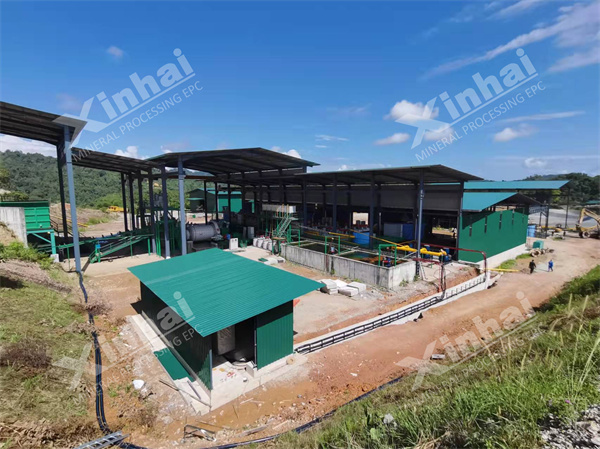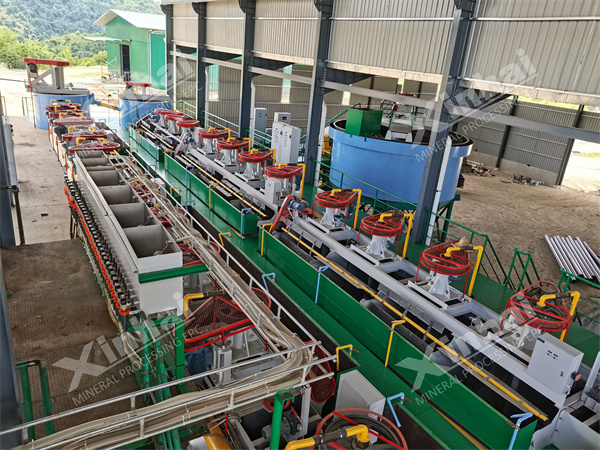Lead and zinc are important industrial metals widely used in construction, transportation, electronics, energy and other fields. In electric vehicles and renewable energy, zinc air batteries and zinc nickel batteries have driven an increase in demand for zinc. Lead is mainly used in lead-acid batteries and still occupies a large market share. Lead and zinc are both obtained from lead-zinc ore through beneficiation and smelting. This article takes the daily processing of 1000 tons of lead-zinc ore as an example to introduce the required beneficiation equipment and equipment layout.

For a daily processing plant of 1000 tons of lead-zinc ore, the main equipment required includes:
(1) Crushing equipment: Jaw crusher, cone crusher, or hammer crusher, used to crush ore to a size suitable for grinding. PE-600 × 900 jaw crusher can be selected for primary crushing; CS-160 cone crusher, used for secondary crushing.
(2) Grinding equipment: Ball mill or rod mill, used to finely grind the crushed ore for subsequent beneficiation operations. MQG-2736 ball mill can be selected, with a cylinder diameter of 2700mm and a length of 3600mm.
(3) Flotation equipment: Flotation machine, used for flotation separation of lead zinc ore. SF-8 flotation machine can be selected for rough selection and selection, XCF/KYF flotation machine, used for rough and sweeping selection.
(4) Classification equipment: Spiral classifier or cyclone, used to control the fineness of grinding and achieve the required particle size.
(5) Dehydration equipment: Dehydration screen, filter or thickener, used to treat tailings and concentrate after flotation. NZS-15 thickener can be selected for concentrating and flotation of lead zinc concentrate. The TS-1845 type dewatering screen can be selected for concentrate and tailings dewatering.
(6) Reagent addition system: used to add various mineral processing reagents, such as lime, copper sulfate, ethyl xanthate, etc.
(7) Conveying equipment: Belt conveyor, used for conveying ores and products. DT-75 tape conveyor can be selected.
(8) Feeding equipment: vibrating feeder or bucket elevator, used for uniform feeding of ore. GZD-960 × 3800 vibrating feeder can be selected.
(9) Mixing equipment: Mixing drum or mixing tank, used to mix mineral slurry and chemicals.
(10) Pressure filtration equipment: used to filter tailings and reduce environmental pollution. XGZ-150/2000 filter press can be selected for concentrate dewatering.
(11) Control system: An automated control system used to monitor and regulate the entire beneficiation process.
The selection and configuration of the above equipment need to be designed and optimized based on specific ore characteristics, beneficiation process flow, and production requirements.

A daily processing plant for 1000 tons of lead-zinc ore requires the connection and reasonable layout of these equipment according to a certain process. The process is as follows:
(1) Feed the raw ore into the jaw crusher through a feeder for primary crushing; The ore after primary crushing is fed into the cone crusher through a conveyor belt for secondary crushing.
(2) The ore after secondary crushing is sent to the ball mill for grinding through a conveyor belt; The slurry after grinding enters the spiral classifier for classification, the coarse particles return to the ball mill for further grinding, and the fine particles enter the next flotation step.
(3) The finely ground slurry enters the flotation machine and undergoes rough selection, selection, and sweeping, respectively using SF-8 flotation machine and XCF/KYF flotation machine.
(4) The flotation concentrate slurry is sent through pipelines to an efficient thickener for concentration; The concentrated concentrate slurry enters the filter press for dehydration to obtain the final concentrate.
(5) The flotation tailings are sent through pipelines to the tailings dewatering screen for dewatering treatment, and the dehydrated tailings are transported by conveyor belts to the tailings pond for stacking.
Device connection diagram (schematic)
Raw Ore → Vibrating Feeder → Jaw Crusher → Cone Crusher → Ball Mill → Spiral Classifier → (Coarse Particles Return to Ball Mill) → Flotation Machine (Roughing, Cleaning, Scavenging) → Thickener → Filter Press → Concentrate ↓ Tailing Dewatering Screen → Tailing Pond
The specific models and configurations of these devices may be adjusted based on the characteristics of the ore and the actual situation of the factory area. In the actual design and construction process, it is recommended to consult professional ore dressing engineers to ensure the rationality of the process flow and the optimization of equipment selection.